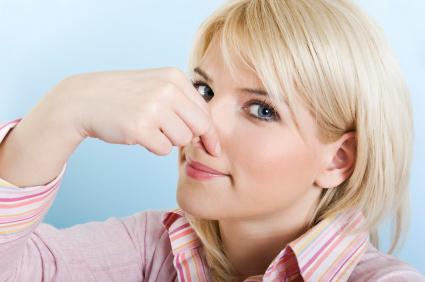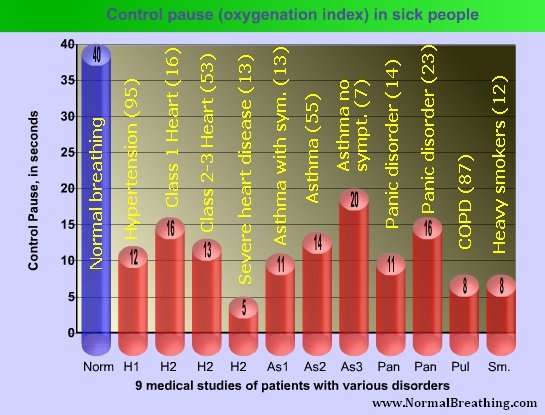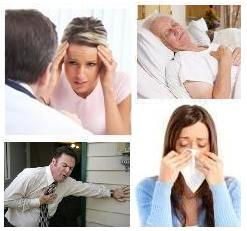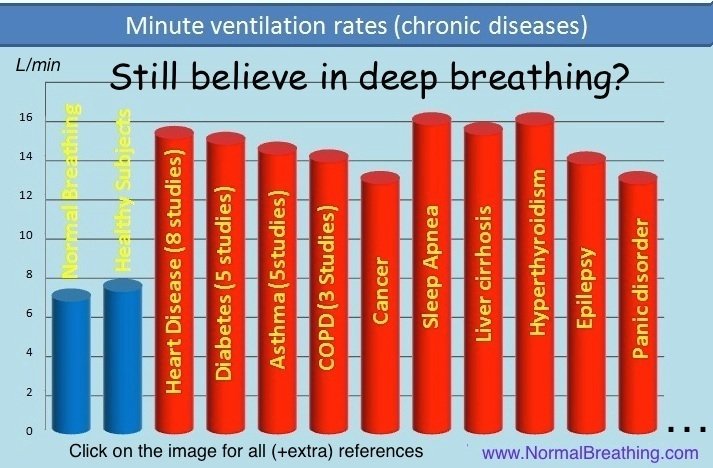- Updated on September 13, 2020
![]() By Dr. Artour Rakhimov, Alternative Health Educator and Author
By Dr. Artour Rakhimov, Alternative Health Educator and Author
- Medically Reviewed by Naziliya Rakhimova, MD
Measure CP: A DIY Test Measuring Body Oxygen Levels
The Buteyko Control Pause (CP) measures body oxygen levels, evaluating minute ventilation (i.e., breathing rates) through a simple test of stress-free breath holding. To date, this do-it-yourself test has been used by more than 200 Soviet and Russian medical doctors, as well as many other health professionals. They’ve checked over 250,000 patients with various health states. Hundreds of Western Buteyko practitioners, too, have applied this test to more than 200,000 people.
Collective data from CP tests, in clinical and experimental settings, highlight major trends between health status, body oxygen levels, and breathing.
 First, how to use the CP test?
First, how to use the CP test?
Ensure there is no solid food in your stomach. (Water is OK.) Sit down for 5 to 7 minutes and allow your breathing to normalize. Then completely relax all muscles, including your breathing muscles. This relaxation will produce a natural, spontaneous exhalation. (There is no need to push the air out from your lungs; simply allow yourself to exhale.) Once this happens, pinch your nose closed and count your breath-holding time in seconds. When you experience the first desire to breathe, release your nose and record the BHT.
Practice shows that the first desire to breathe appears together with an involuntary push of the diaphragm and/or a swallowing movement in the throat. If you release the nose and start breathing at this time, you can resume your usual breathing pattern (i.e., the same way you were breathing prior to the CP test).
Do not hold your breath for too long, trying to increase the result. You should not gasp for air or open your mouth when you release your nose; the test should be easy and not cause you any stress. In other words, it shouldn’t interfere with your breathing, as shown below:

![]() Warning: Some, but not all, people with heart disease, migraine headaches, and panic attacks may experience negative symptoms minutes later even after a stress-free breath hold. If this happens, they should avoid this test in the future, and use pulse to monitor progress in their breathing retraining.
Warning: Some, but not all, people with heart disease, migraine headaches, and panic attacks may experience negative symptoms minutes later even after a stress-free breath hold. If this happens, they should avoid this test in the future, and use pulse to monitor progress in their breathing retraining.
Some people can have abnormally large CP numbers. This can happen in cases of carotid body resections, denervation of respiratory muscles, and near-death experiences. People with sleep apnea and lost or blunted CO2 sensitivity, can also have exaggerated test results.
At the same time, cases of people with normal breathing (and normal body O2 content) who have low results for the CP test are virtually unknown.
What do body-oxygen test numbers look like for sick people? Healthy people?
Consider the following from a recent university physiology textbook:
“If a person breath-holds after a normal exhalation,
it takes about 40 seconds before breathing commences”
From the textbook Essentials of Exercise Physiology,
McArdle W.D., Katch F.I., Katch V.L. (2nd edition);
Lippincott, Williams and Wilkins, London 2000, p.252.
As shown in the chart below, CPs well below 40 seconds correlate with the onset of disease:

This table above, as well as the one below, summarize more than three dozen Western medical and physiological research studies that have observed breathing in various populations. In short, they’ve found that:
– The body-oxygen test in sick people (13 medical studies) is less than 20 seconds.
– The body-oxygen test in healthy people (24 references) is between 20 to 30 seconds today (and 40 to 50 seconds 80 to 100 years ago).
 Doctor Buteyko and his medical colleagues tested more than 250,000 Soviet and Russian patients and found that the following relationships generally hold true:
Doctor Buteyko and his medical colleagues tested more than 250,000 Soviet and Russian patients and found that the following relationships generally hold true:
1-10 secs. CP: severely sick, critically and terminally ill patients, usually hospitalized;
10-20 secs. CP: sick patients with health complaints, often on daily medication;
20-30 secs. CP – people with average health, usually without serious chronic health problems;
40-60 secs. CP: very good health;
60 secs + CP: – robust health, when many chronic diseases are virtually impossible.
There are cases of people who have poor results (less than 20 secs.), but who do not suffer from chronic diseases. Such people typically do not have a genetic predisposition to chronic disease. That said, low body O2 always compromises health and fitness, energy levels, and overall quality of life to some degree.
Correct Buteyko CP (Control Pause) Test, CP Versions
In the video below, Dr. Artour explains different CP versions and related effects:
How does the body-oxygen test relate to your automatic breathing?
 Medical evidence suggests that sick people are heavy breathers. The bigger your breathing, the smaller your body-oxygen levels.
Medical evidence suggests that sick people are heavy breathers. The bigger your breathing, the smaller your body-oxygen levels.
– If you have about 40 seconds for the body oxygen test, you have normal breathing with about 5-7 L/min for minute ventilation (i.e., how much air you breathe in.).
– If your time is 20 secs., you breathe for two people — twice more air than the medical norm.
– If you have 10 secs. of oxygen in the body or less, you breathe for at least four people.
After testing thousands of their patients, Soviet MDs found that this CP test accurately predicts numerous lifestyle choices, symptoms, and habits of people. This includes their energy levels, frequency of fatigue, desire to exercise, mental states, stress levels, addictions, cravings, desire to eat raw foods, usual postures, and even sleep quality and sleep duration. I’ve also found this true for hundreds of my breathing students. A summary of this information is present in the table hidden as bonus content below.
Natural lifestyle choices before and after breathing retraining
| Lifestyle factor: | Body oxygen < 30 secs. | Body oxygen > 50 secs. |
| Energy level | Medium, low, or very low | High |
| Desire to exercise | Not strong, but possible | Craving and joy of exercise |
| Intensive exercise with nose breathing | Hard or impossible | Easy and effortless |
| Typical mind states | Confusion, anxiety, depression | Focus, concentration, clarity |
| Craving for sugar and junk foods | Present | Absent |
| Addictions to smoking, alcohol, and drugs | Possible | Absent |
| Desire to eat raw foods | Weak and rare | Very common and natural |
| Correct posture | Rare and requires efforts | Natural and automatic |
| Sleep | Often of poor quality; > 7 hours | Excellent quality; < 5 hours naturally |
[/sociallocker]
The bottom line is this: if you breathe less, you naturally increase your body oxygen levels. This is the aim of the Buteyko Method.
While the Buteyko Method uses the CP test as the main health parameter, it is not the only one. See factors that affect health for more details.
If you’d like more guidance about how to do the Buteyko Control Pause (CP), or whole body oxygen test, see the video clip here.
Additional References
- How to Measure Blood Oxygen (WikiHow.com)
- Is My Blood Oxygen Level Normal? (HealthLine.com)
- How to measure one’s own breathing? (Nirvana Fitness)


